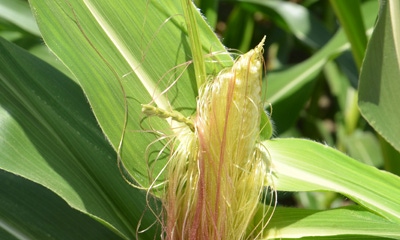
If you have 1,000 acres of corn and 30,000 plants per acre, you have 30 million plants busy producing ears of corn right now. Given that large of a population, it’s not unusual to find a few oddities in ear formation or plant development while scouting cornfields this time of year. What would be unusual is if you didn’t find an oddity now and then in that many plants.
Dave Nanda, crops consultant for Seed Consultants Inc., sponsor of Crop Watch ’16, says even with modern genetics, corn is still a living organism. Occasionally, as in the human population, mistakes will happen.

MALE OR FEMALE? Look closely and you can see a few spikes of what should be the tassel poking out from a cob with long, colorful silks. It’s an oddity, but it’s isolated, so it won’t impact yield.
Sometimes oddities found in the field are linked to disease. For example, crazy top is a fungal disease that causes plants to produce a mass of unorganized leaf matter where the tassel should be. According to the Purdue University Corn and Soybean Field Guide, this disease appears most often in fields that were wet or ponded after planting. Spores of the disease living in the soil are triggered and infect plants early in the season. The effects don’t show up until later. Not every plant will be affected by crazy top, but you will typically find a smattering of plants within an area that was wet or ponded early if the disease appears.
Just odd
The plant pictured here is much shorter than the surrounding plants. While other plants were tasseling, it had produced an ear of sorts, a cob with silks hanging downward. The silks continued growing since they were not pollinated.
Look closely and you can see a couple of spikes where the tassel normally would appear. This was the only plant with this sort of deformity found while scouting a 20-acre field for half an hour.
What’s depicted here isn’t crazy top. Whether it was triggered by another pathogen or some oddity in development of the plant isn’t clear. What is clear is that while it definitely attracts attention, since it seems to be an isolated case in a sea of thousands of plants, overall yield won’t be impacted at all.
Noting these oddities and recording them in pictures makes sense, just in case they should show up again. However, Nanda notes that an isolated plant such as this one isn’t a cause for concern.
About the Author(s)
You May Also Like




